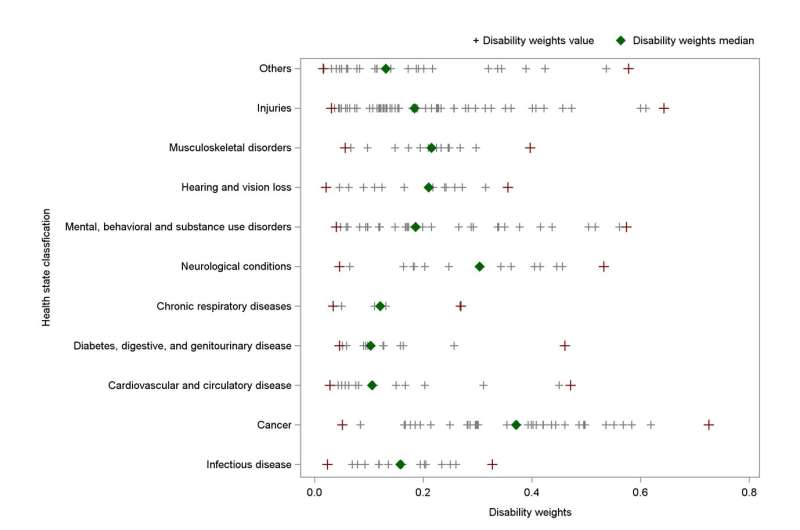This article has been reviewed according to Science X's editorial process and policies. Editors have highlighted the following attributes while ensuring the content's credibility:
fact-checked
trusted source
proofread
Findings from disability weights measurement in China with a focus on the effect of disease burden

The Global Burden of Disease (GBD) is a systematic study that compares the magnitude of health losses to various diseases and injuries worldwide. Disability weights are crucial for quantifying health loss associated with non-fatal outcomes and were not well assessed in different countries, especially for specific cancer. Therefore, this study aimed to identify disability weights with a focus on specific cancer in a large Chinese population.
This study was led by Prof. Wenqiang Wei (National Cancer Center/National Clinical Research Center for Cancer/Cancer Hospital, Chinese Academy of Medical Sciences and Peking Union Medical College).
Two types of web surveys were conducted, and 254 health states, including 30 new states for specific cancer, were investigated using paired comparison methods. The years lived with disability (YLDs) of cancer were calculated as the sum of the prevalence of each sequela of cancer multiplied by its relative disability weight.
In total, 44,069 participants were eligible for the disability weights study. The disability weights of 254 health states were estimated. Among those, the disability weights of 18 specific cancer types varied greatly at diagnosis and primary treatment stage, with the value ranging from 0.619 (95% uncertainty interval (UI) 0.606–0.632) for brain cancer to 0.167 (95% UI 0.158–0.176) for oropharyngeal cancer.
The variation of disability weight for different cancers at metastatic phase was similar to the diagnosis and primary treatment stages, and the highest was still brain cancer (0.726, 95% UI 0.717–0.736), whereas the lowest was oropharyngeal cancer (0.402, 95% UI 0.395–0.408). The discrepancy in YLDs calculated by different disability weights was high, and the largest gap for all cancer combined was approximately 30.1%.
When calculated using the cancer-specific disability weights, a total of 1,967,830 (95% UI 1,928,880–2,008,060) YLDs of cancer in China. Among them, lung cancer, breast cancer, thyroid cancer, colorectal cancer and stomach cancer with the heaviest burden of YLDs, and those top five cancers accounting for about 60% of the YLDs.
The disability weights of cancer varied greatly among cancer types and populations, which had considerable influence on the estimation of the disease burden. Cancer-specific disability weights could provide a more accurate evaluation of the cancer burden.
The work is published in the journal Science Bulletin.
More information: Shaoyuan Lei et al, Years lived with disability of cancer in China: findings from disability weights measurement with a focus on the effect of disease burden, Science Bulletin (2023). DOI: 10.1016/j.scib.2023.06.013


















